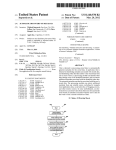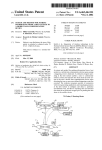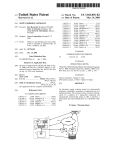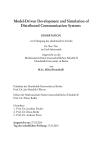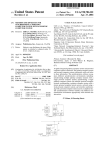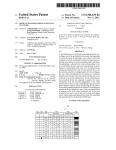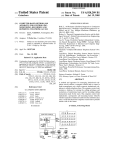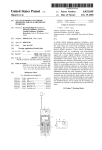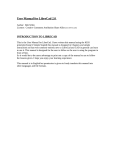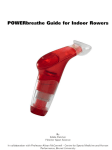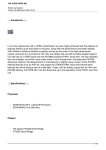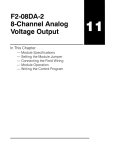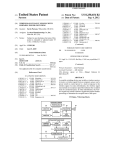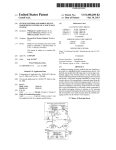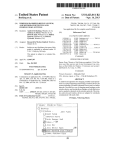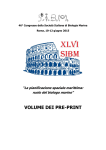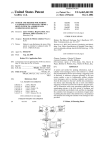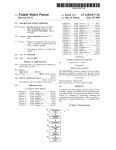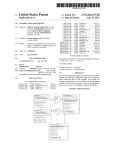Download System and method for pushing information from a host system to a
Transcript
US006389457B2 (12) (54) United States Patent (10) Patent N0.: Lazaridis et al. (45) Date 0f Patent: SYSTEM AND METHOD FOR PUSHING INFORMATION FROM A HOST SYSTEM TO A DEVICE MOBILE DATA COMMUNICATION US 6,389,457 B2 *May 14, 2002 FOREIGN PATENT DOCUMENTS g1? EP 0736989 (75) Inventors: Mihal Lazaridis; Gary P. Mousseau, both of Waterloo (CA) 10/1996 (List Continued on next page) OTHER PUBLICATIONS (73) Assignee: Research In MOtiOn Limited, Waterloo F'b ' kAg e1 us, “ADkpIY es to n our Pl”If am , n ormat1onWee , u . CA ' ~ ( * ) Nonce: ~ ~ ~ SubJeCt_tO any dlsclalmeri the term of thls pjatsenct iise‘xéenkded) oir adJusted under 35 ' ' ' ( ) y ays' 25, 1997, pp. 65ff. Behr, “Handheld Solutions”, InformationWeek, Oct. 27, 1997, pp 106_113_ Moody’s Investors Service, Socket Communications Inc.— This atent is Subbct to a terminal dis_ History & Debt, InvesteX Report No. 3240276. [Note: This claimgr reference Was cited by Examiner in 09/087,623, but copy 1 ' never provided. Please see parent case.]. (21) Appl- NO? 09/782,380 ( 22 ) El d: 1e (List continued on neXt page.) F b. 13 2001 e ’ Primary Examiner—Glenn Burgess Related US Application Data (63) Continuation of application No. 09/087,623, ?led on May 29 1998 ’ (51) Assistant Examiner—Bradley Edelman (74) Attorney, Agent, or Firm—Jones, Day, Reavis & Pogue; Krishna K- Pathiyal; Charles B- Meyer P t. N . 6 219 694. ’“°W a O ’ ’ (57) ABSTRACT Int. Cl.7 ..................... .. G06F 15/16; G06F 15/173; G061? 17/()0-, H()4 Q 7/()0 A s y stem and method for P ushin g information from a host (52) US. Cl. ..................... .. 709/207; 709/206; 709/245; 709/238,- 340/721,- 340/729,- 455/556,- System 9 a mobile fiat? communicatiop device upon Sensing a trI gg erm g event is d 1scose 1 d . A re d 1rector p ro g ram 0 9 er 707/201 340/7 54 7 29 238 2'53’ ating at the host system enables a user to continuously redirect certain user-selected data items from the host sys tem to the user’s mobile data communication device upon 20,7. 455/55’5_55’7, 70,7001’ detecting that one or more user-de?ned triggering events has (58) Field of Search 340 ’ ’ ’ (56) 5,086,502 5,159,592 5,313,582 5,392,390 5,410,543 5,416,473 ’ occurred. The redirector program operates in connection References Cited With event generating applications and repackaging systems U.S. PATENT DOCUMENTS at the host system to con?gure and detect a particular user-de?ned event, and then to repackage the user-selected data items in an electronic Wrapper prior to pushing the data A A A A A A 2/1992 10/1992 5/1994 2/1995 4/1995 5/1995 Malcolm Perkins Hendel et al. CroZier SeitZ et al. Dulaney, III et al. items to the mobile device. The host system can be a desktop computer that stores and redirects messages received from a netWork to the mobile device and also stores and redirects messages received from the mobile device to the netWork. 12 Claims, 5 Drawing Sheets (List continued on neXt page.) 10 DESKTOP j 3031mm REDIREELION SOFTIARE US 6,389,457 B2 Page 2 US. PATENT DOCUMENTS 5,416,842 A 6,034,621 A 6,035,104 A 6,052,563 A Fleming, 111 5,436,960 A 7/1995 CamPanaJr- er 91- 6,052,735 A 5,438,611 A 8/1995 Campana, JI- et 91- 6,058,431 A 5452356 A 9/1995 Albert 6,073,165 A 5,479,472 5,487,100 5,493,692 57495484 5572528 5,579,472 5,588,009 5598536 576037054 A A A A A A A A A 12/1995 1/1996 2/1996 2/1996 11/1996 11/1996 12/1996 1/1997 2/1997 Campana, Jr. et al. Kane Theimer et al. Self“ 91Shuen Keyworth, 11 et al. Will Slaughter, III er 91Thelmer et @1- 6,084,969 6,085,231 6,085,232 6,091,951 6,092,114 6,092,191 6,101,531 6,115,394 6,115,736 A A A A A A A A A 3/2000 Kaufman 3/2000 Zahariev 4/2000 Macko * 4/2000 Ulrich etal. ............. .. 709/236 5/2000 Srisuresh et al. * 6/2000 Narasimhan et al. ..... .. 709/206 7/2OOO 7/2000 7/2OOO 7/2000 7/2000 7/2OOO 8/2000 9/2000 9/2000 Wright et a1' Agraharam et al. Kikinis Sturniolo et al. Shaffer et al. Shimbo et 81' Eggleston et al. Balachandran etal. Devarakonda et al. 5,604,788 A 2/1997 Tett .......................... .. 455/412 6,125,281 A g/ZOOO Wells et a1' 5,625,670 A 4/1997 Campana, Jr. et al. 6,128,739 A 1O/2OOO Fleming’ HI “V2000 Short et aL 5,627,829 A 5/1997 Gleeson et al. 6,130,892 A 5,630,060 A 5/1997 Tang et al. ............... .. 709/238 6,134,432 A 10/2OOO Holmes et a1' 5,631,946 A 5,633,810 A 5/1997 Campana, Jr. et al. 5/1997 Mandal et al. 6,138,146 A 6,141,690 A 1O/2OOO Moon et a1' 1O/2OOO Weiman 57638450 A 6/1997 Robs?“ 6,144,671 A 11/2000 Perinpanathan etal. 5,666,553 A 5673322 A 5,706,211 A 9/1997 CIOZICI 9/1997 Pepe er 911/1998 Beletic et al. 6,154,839 A 6,157,950 A 6,163,274 A 11/2000 Arrow etal. 12/2000 Krishman 12/2000 Lindgren 5,727,202 A 5729735 A 5737531 A 3/1998 Kucalé 3/1998 Meyermg 4/1998 Ehley 6,167,379 A 6,240,088 B1 6,249,820 B1 12/2000 Dean etal. 5/2001 Gayton etal. 6/2001 Dobbins etal. 5,745,689 5,742,905 A 5,751,960 A 4/1998 Yeager Pepe et eral.915/1998 Matsunaga 6,272,545 6,256,666 B1 6,275,848 B1 8/2001 7/2001 Flanagin et al. 8/2001 Arnold 5,751,971 A 5,754,954 A 5/1998 DObbiIlS et al. 5/1998 Cannon et al. 6,275,850 B1 8/2001 Beyda et aL 5.757901 A 5/1998 Hiroshige 5,761,416 A 5,765,170 A 6/1998 Mandal et al. 6/1998 Morikawa EP 0772327 A2 5,781,614 A 7/1998 Brunson ................ .. 379/88.14 EP 0777394 6/1997 5,781,901 A 5,790,790 A 7/1998 KuZma 8/1998 Smith et al. EP EP 0788287 09214556 8/1997 8/1997 5,790,974 A 8/1998 TognaZZini EP 0793387 9/1997 5,812,819 5,813,016 5,819,172 5,819,284 5,822,434 5,826,062 5,838,252 A A A A A A A 9/1998 9/1998 10/1998 10/1998 10/1998 10/1998 11/1998 Rodwin et al. Sumimoto Campana, Jr. et al. Farber et al. Caronni et al. Fake, Jr. et al. Kikinis FOREIGN PATENT DOCUMENTS EP EP EP EP EP JP US 0825788 0838774 0838934 0772327 A3 0930766 11289346 0001552 5/1997 2/1998 4/1998 4/1998 2/1999 7/1999 10/1999 5/2001 5,838,926 A 11/1998 Yamagishi US 2001-0029531 10/2001 5,844,969 5,867,660 5,878,434 5,889,845 5,903,723 5,905,777 12/1998 2/1999 3/1999 3/1999 5/1999 5/1999 W0 W0 W0 W0 W0 W0 9619064 9726709 9727717 9732251 9733421 9741654 6/1996 7/1997 7/1997 9/1997 9/1997 11/1997 W0 W0 9744942 9800787 11/1997 1/1998 W0 W0 W0 W0 982191 9823108 9848560 9945484 5/1998 5/1998 10/1998 9/1999 A A A A A A 5,913,040 A 5,937,161 A 5,941,956 5,948,066 5,953,322 5,961,590 A A A A 5,964,833 A 5,974,180 A 5,974,238 A Goldman et al. Schmidt et al. Draper et al. Staples et al. Beck et al. Foladare et al. 6/1999 Rakavy et al. ............ .. 709/232 8/1999 Mulligan et al. ......... .. 709/206 8/1999 9/1999 9/1999 10/1999 Shirakihara et al. Whalen et al. Kimball MendeZ et al. 10/1999 Kikinis 10/1999 Schwendeman 10/1999 Chase, Jr. OTHER PUBLICATIONS 5,978,837 A 11/1999 Foladare et al. Newsletter, E—Mail Merges With Voice Through In?nite 5,983,073 A 11/1999 Ditzik Technologies, Voice Technology & Services News, May 26, 57987508 A 5,995,597 A 6,000,000 A 11/1999 Agraharam et a1~ 11/1999 WoltZ etal12/1999 Hawkins et al. 1998. [Note: This reference was cited by Examiner in 09/087,623, but copy never provided. Please see parent easel 6,006,274 A 12/ 1999 Hawkins et al. 6,014,429 A 6,018,762 A 6,023,700 A 1/2000 Laporta et a1_ 1/2000 Brunson et a1, 2/2000 Owens et al. _ _ Newsletter, Vodapage: Vodapage demos increasing conver gence of pagers and mobile communications at TMA 29, M2 Presswire, Nov. 28, 1996. US 6,389,457 B2 Page 3 Mosher, Microsoft Exchange User’s Handbook, Duke Press, 1997, pp. 547—549. [Note: This reference Was cited by Examiner in 09/087,623, but copy never provided. Please see parent case.]. Copy of DTS Wireless Website located at D.R.L. http:// WWW.dtsWireless.com. “3Com PalmPilot Gets Wireless Link for E—Mail”, Spooner, John G., PC Week, Dec. 8, 1997. “Have Your Pager Call My Pager”, Sullivan, Kristina B., PC Week, Dec. 8, 1997. NeWs Release, “Motorola Rings in 1995 With the Launch of the Marco® Wireless Communicator,” Jan. 4, 1995 (4 pgs.). Timeline, “FLEXTM Technology Timeline,” (3 pgs.). General Magic, Inc., Corporate Backgrounder, 2001 (2 pgS-)~ Pegasus Email Settings, ABSnet Internet Services, Inc. (4 Cheshire, Stuart, et al., “Internet Mobility 4x4,” Computer Science Department, Stanford University, pp. 1—12, Aug. 1996. Yeom, Hoen Y, et al., “IP Mutliplexing by Transparent Port—Address Translator,” Proceedings of the Tenth USENIX System Administration Conference, pp. 113—122, Sep. 29—Oct. 4, 1996. Johnson, David B., “Scalable and Robust InternetWork Routing for Mobile Hosts,” IEEE Computer Society, pp. 2—11, 1994. Perkins, Charles, “IMHP: A Mobile Host Protocol for the Internet,” Computer NetWorks and ISDN System, vol. 27, pp. 479—491, 1994. pgS-)~ Proceedings of the IEEE 7th International Workshop on Motorola, Inc., emailVClient, 2001 (4 pages). NetWork and Operating System Support for Digital Audio and Video, Innsbrook Estates Conference Center, May NeWs Release, “Motorola Announces PageWriter 250, The World’s Smallest Pager With Full Keyboard”, Feb. 27, 1997 (2 PgS-) 19—21, 1997, pp. 135—146. DeWey, Barney, “Communications Strategies for NeWton 2.0,” NeWton Technology Journal, p. 10, Jun. 1996. Lucent Technologies, Bell Labs Technical Journal, vol. 2, No. 3, pp. 152—163, Summer 1997. Press Release, “Motorola Announces NeW Solutions to Provide Consumers With Wireless Access to Personal and Lavana, Hemang, et al., Internet—Based Work?oWs: A Para Enterprise E—mail Accounts,” Mar. 21, 2001 (4 pgs.). digm for Dynamically Recon?gurable Desktop Environ “Motorola’s ‘Marco’ Wireless Communicator,” http://WW ments, Group 97, pp. 204—213, 1997. W.msu.edu/—luckie/gallery/marco.htm, Jun. 14, 2001 (3 Perkins, Charles E., et al., “Mobility Support in IPv6,” Mobicom 96, pp. 27—37, 1996. PgS-) NeWs Release, “CE SoftWare Announces MobileVision,” Editorial Contacts, CE SoftWare, Inc., 1995 (3 pgs.). NeWs Release, “CE SoftWare Ships MobileVision,” Jun. 20, 1995 (3 pgs.). NeWton Reference, Communications, 1996—1997(4 pgs.). PC Pro Issue 31: RealWorld Computing, PDA Column, Jul. 30, 1997 (7 pgs.). Enterprise Solutions for Email Overload, Founder Publica tions, http://WWW.amikanoW.com/corporte/publication s.htm, Aug. 6, 2001 (9 pgs.). “Motorola’s ‘Marco’ Wireless Communicator,” http://WW W.msu.edu/—luckie/gallery/marco.htm, Aug. 6, 2001 (2 pgS-)~ Press Release, “Apple Agrees to License NeWton Technol ogy to Schlumberger, Digital Ocean,” Nov. 3, 1995 (3 pgs.). FreZZa, Bill, “PDA, PDA, Wherefore Art Thou, PDA?”, GoldsZmidt, German, et al., “ShockAbsorber: A TCP Con nection Router,” IEEE, vol. 3, pp. 1919—1923, 1997. Egevang, K. et al., “The IP NetWork Address Translator,” NetWork Working Group, pp. 1—10, May 1994. Manual, “Server and BBS SoftWare for the Packet Radio” by Jean Paul Roubelat, pp. 1—173. Book, “InternetWork Mobility The CDPD Approach,” by Mark S. Taylor, William Waung, and Mohsen Banan, Jun. 11, 1996. “BlackBerry Technical White Paper,” Research in Motion Ltd., Version 1.0, 1998—1999. NeWsletter, “Battery Friendly Bulletin,” vol. 1, Issue 3, pp. FreeWire, Aug. 6, 2001 (6 pgs.). 1—7 and unnumbered page, 1999. Black, Lauren, et al., “Personal Digital Assistants,” Mac Article, Comerford, “Handhelds Duke It Out for the Inter net,” Wireless Internet, pp. 35—38 and 41, Aug. 2000. World RevieWs, Aug. 6, 2001 (5 pgs.). Reference, “MobileVision Direct Wireless Connection to Your LAN—Based Electronic Mailbox,” CE SoftWare, Inc., pp. 1, 3, 5, 7, 9, 11, 13, 15, 17, 19, 21, 1995. User Manual, “MobileVision Direct Wireless Connection to Your LAN—Based Electronic Mailbox,” CE SoftWare, Inc. 1995. Johnson, David B., “Ubiquitous Mobile Host InternetWork ing,” Fourth Workshop on Workstation Operating systems, pp. 85—90, Oct. 14—15, 1993. Johnson, David B., “Mobile Host InternetWorking Using IP Loose Source Routing,” School of Computer Science, Car negie Mellon University, pp. 1—14 Feb. 1993. Schoettle, Bob, “IP—Address Management on LANs,” Byte, pp. 199—200, Feb. 1996. Press Detail, “Extended Systems and Motorola Bring Shor t—Range Wireless to the Paging E—volution,” Jan. 13, 2000 Press Detail, “3Com Corporation License Bluetooth Tech nology from Extended Systems,” Feb. 22, 2000 (2 pp.). Web site Article, HaWaleshka, “The Web in Your Pocket,” Macleans’s, May 15, 2000 (3 pp.). Claxton, “Messaging API’s for Voice NetWorks,” Telecom munications, pp. 116—120, 1998. * cited by examiner U.S. Patent May 14, 2002 US 6,389,457 B2 Sheet 1 0f 5 ___ ‘510 EOMPUTER DESKTOP ’ REDIRECLION SOFTWARE S l 2 K30 FAX 0R VOICE MACHINE WIRELESS GATEWAY U.S. Patent May 14, 2002 Sheet 2 0f 5 US 6,389,457 B2 28? A 2;; SA LOCAL AREA NETWORK .' ‘K (LAN) 1 1 2’ COMPUTER SERVER REDIRECTION SERVER 12L SOFTWARE ' _____ " 30 / FAX 0R VOICE MACHINE WIRELESS ‘___ __, g GATEWAY 20 MOBILE % COMPUTER --— 22 \24 U.S. Patent May 14, 2002 US 6,389,457 B2 Sheet 3 0f 5 /-14 LOCAL AREA NETVORK [LANI I IOA / 40 TCP/IP SUB-SYSTEM [-44 E-MAIL SUB-SYSTEM PRIMARY STORE ALTERNATE LINK MAIN LINK REOIRECTOR PROGRAM SETUP EVENTS TRIGGER SETUP EVENTS TRIGGER 48 X f 46 SCREEN SAVER SUB-SYSTEM KEYBOARD SUB-SYSTEM DESKTOP COMPUTER Fig. 3 U.S. Patent May 14, 2002 Sheet 4 0f 5 US 6,389,457 B2 REDIRECTION J~50 SoETvARE STARTEG INSTALL TRIGGER 52 POINTS IN I SYSTEM /' < SET TRIGGER 54 / “E2???” NA -——> F TREG FLAG (S6 58 NATT FOR MESSAGES ANG- YES SIGNALS 72 roRNARG I , T0 um 1 ADD ouTER 60 ENVELOPE ‘5 T0 N0 NEH E-MAIL MES§AGE M U.S. Patent May 14, 2002 Sheet 5 0f 5 MOBILE SOFTTTARE 84 US 6,389,457 B2 EOMPOSE AND SEND TO DESKTOP STARTED f , YES MESSAGE AND lWL “IT FOR MESSAGES AND * SIGNALS \/ 82 98) PRESENT TO USER 96j “ REMOvE OUTER 94 ENVELOPE I 7 SET DESKTOP M REDIRECTION FLAG ON 100 / TOG SEND TO IS USER — DESTINATION USING DESKTOP ADDRESS SOETTTARE f 1 I0 108 ‘ PUT OUTER ENVELOPE ON MESSAGE AND REDIRECTION 1 ADDRESS TO DESKTOP FLAG ON ? 1 A Fig. 5 US 6,389,457 B2 1 2 SYSTEM AND METHOD FOR PUSHING INFORMATION FROM A HOST SYSTEM TO A MOBILE DATA COMMUNICATION DEVICE With these synchronization systems is that the only time that CROSS-REFERENCE TO RELATED APPLICATION message until the next time the user fetches the user data items. Thus, a user may fail to respond to an emergency This application is a continuation application of US. patent application Ser. No. 09/087,623, ?led on May 29, 1998, now US. Pat. No. 6,219,694. the user data items are replicated betWeen the host system and the mobile data communication device is When the user commands the mobile device to doWnload or pull the user data from the host system. Five minutes later a neW message could be sent to the user, but the user Would not receive that 10 reconciled betWeen the host and the mobile device can become large if the user does not “synchronize” on a daily BACKGROUND OF THE INVENTION The present invention is directed toWard the ?eld of replicating information from a host system Where the infor mation is normally stored to a mobile data communication device. In particular, the system and method of the present invention provide an event-driven redirection computer pro update or message because the user only periodically syn chronizes the system, such as once per day. Other problems With these systems include: (1) the amount of data to be or hourly basis, leading to bandWidth dif?culties, particu 15 gram (“redirector program”) operating at the host system, Which, upon sensing a particular user-de?ned event has occurred, redirects user-selected data items from the host system to the user’s mobile data communication device. The mobile data communication device is preferably coupled to the host system via a Wireless netWork and one or more 25 landline netWorks. Due to the bandWidth limitations of Wireless networks, only a portion of a user-selected data item is generally redirected to the user’s mobile device, With the user given the option of then retrieving the entire data item (or some other portion of the data item) from the host system. Instead of Warehousing (or storing) the user’s data items larly When the mobile device is communicating via a Wire less packet-sWitched netWork; and (2) reconciling large amounts of data, as can accrue in these batch-mode syn chronization systems, can require a great deal of communi cation betWeen the host and the mobile device, thus leading to a more complex, costly and energy-inef?cient system. A more automated, continuous, ef?cient and reliable system of ensuring that user data items are replicated at the user’s mobile device is therefore needed. An additional feature of the present invention is that the push paradigm, in combination With a return communica tions pathWay, lends itself Well to a system that permits a user to control remotely, through the user’s mobile device, a number of aspects of the host system. There remains a general need in this art for a system and method of continuously pushing user-selected data items (or certain portions of the selected data items) stored at a host system to a user’s mobile data communication device. There remains a more particular need for such a system at the host system and then “synchronizing” the mobile data communication device to data items stored at the host and method Where user-selected data items are continuously system When the mobile device requests that such items of 35 “pushed” from the host system to the mobile data commu information be communicated to it, the present invention nication device upon the occurrence of one or more user employs a “push” paradigm that continuously packages and de?ned triggering events. retransmits the user-selected items of information to the mobile data communication device in response to a trigger ing event detected at the host system. Wireless mobile data communications devices, especially those that can return a method that provides ?exibility in the types and quantities of con?rmation signal to the host that the pushed data has been received are especially Well suited for this type of push There remains an additional need for such a system and user data items that are pushed from the host system to the mobile data communication device and that also provides ?exibility in the con?guration and types of events that can serve to trigger the redirection of the user data items. There remains yet an additional need for such a system Present systems and methods for replicating information 45 and method that can operate locally on a user’s desktop PC from a host system to a user’s mobile data communication or at a distance via a netWork server. device are typically “synchronization” systems in Which the There remains still another need for such a system and paradigm. user’s data items are Warehoused (or stored) at the host system for an inde?nite period of time and then transmitted in bulk only in response to a user request. In these types of systems and methods, When replication of the Warehoused data items to the mobile device is desired, the user typically places the mobile device in an interface cradle that is electrically connected to the host system via some form of local, dedicated communication, such as a serial cable or an 55 infrared or other type of Wireless link. SoftWare executing on the mobile data communication device then transmits com mands via the local communications link to the host system to cause the host to begin transmitting the user’s data items for storage in a memory bank of the mobile device. In these synchronization schemes, the mobile unit “pulls” the Ware housed information from the host system in a batch each time the user desires to replicate information betWeen the tWo devices. Therefore, the tWo systems (host and mobile) method that provides for secure, transparent delivery of the user-selected data items from the host system to the mobile device. SUMMARY OF THE INVENTION The present invention overcomes the problems noted above and satis?es the needs in this ?eld for a system and method of pushing user-selected data items from a host system to a user’s mobile data communication device upon detecting the occurrence of one or more user-de?ned event triggers. As used in this application, the term host system refers to the computer Where the redirector softWare is operating. In the preferred embodiment of the present invention, the host system is a user’s desktop PC, although, alternatively, the host system could be a netWork server connected to the user’s PC via a local-area netWork (“LAN)”, or could be any other system that is in commu only maintain the same data items after a user-initiated 65 nication With the user’s desktop PC. command sequence that causes the mobile device to doWn A redirector program operating at the host system enables the user to redirect or mirror certain user-selected data items load the data items from the host system. A general problem US 6,389,457 B2 3 4 (or parts of data items) from the host system to the user’s user Will be spending the evening. This enables the user to receive important E-mail attachments as long as the host mobile data communication device upon detecting that one or more user-de?ned triggering events has occurred. Also system is provided With suf?cient information about the operating at the host system are various sub-systems that can destination Where the attachment is to be forWarded. Once an event has triggered redirection of the user data be con?gured to create triggering events, such as a screen saver sub-system or a keyboard sub-system, as Well as items, the host system then repackages these items in a sub-systems for repackaging the user’s data items for trans manner that is transparent to the mobile data communication device, so that information on the mobile device appears similar to information on the user’s host system. The pre parent delivery to the mobile data device, such as a TCP/IP sub-system or one or more E-Mail sub-systems. Other items for redirection, the user can then con?gure one or ferred repackaging method includes Wrapping the user data items in an E-mail envelope that corresponds to the address of the mobile data communication device, although, alternatively, other repackaging methods could be used With the present invention, such as special-purpose TCP/IP Wrap ping techniques, or other methods of Wrapping the user selected data items. The repackaging preferably results in E-mail messages generated by the user from the mobile device to be transmitted from the host system, thus enabling more event triggers to be sensed by the redirector program the user to appear to have a single E-mail address, such that sub-systems for creating triggering events and repackaging 10 the user’s data items could also be present at the host system. The host system also includes a primary memory store Where the user’s data items are normally stored. Using the redirector program, the user can select certain data items for redirection, such as E-mail messages, calendar 15 events, meeting noti?cations, address entries, journal entries, personal reminders etc. Having selected the data to initiate redirection of the user data items. These user the recipients of messages sent from the mobile communi de?ned trigger points (or event triggers) include external cations device do not knoW Where the user Was physically located When the message Was ?rst sent. The repackaging events, internal events and netWorked events. Examples of external events include: receiving a message from the user’s mobile data communication device to begin redirection; receiving a similar message from some external computer; 25 sensing that the user is no longer in the vicinity of the host system; or any other event that is external to the host system. also permits both messages to the mobile device and sent from the mobile device to be encrypted and decrypted as Well as compressed and decompressed. In an alternative system and method, the redirector pro gram executes on a netWork server, and the server is activation, keyboard timeout, programmable timer, or any programmed to detect numerous redirection event triggers over the netWork from multiple user desktop computers other user-de?ned event that is internal to the host system. coupled to the server via a LAN. The server can receive NetWorked events are user-de?ned messages that are trans internal event triggers from each of the user desktops via the netWork, and can also receive external event triggers, such Internal events could be a calendar alarm, screen saver mitted to the host system from another computer coupled to the host system via a netWork to initiate redirection. These are just some of the examples of the types of user-de?ned events that can trigger the redirector program to push data items from the host to the mobile device. Although in the as messages from the users’ mobile data communication devices. In response to receiving one of these triggers, the 35 preferred embodiment it is anticipated that the con?guration that speci?es Which data items Will be redirected and in What form Will be set at the host system, it is Within the scope of this invention that such con?guration may be set or modi?ed through data sent from the mobile communications device. In addition to the functionality noted above, the redirector program provides a set of softWare-implemented control functions for determining the type of mobile data commu nication device and its address, for programming a preferred list of message types that are to be redirected, and for determining Whether the mobile device can receive and process certain types of message attachments, such as Word server redirects the user’s data items to the proper mobile data communication device. The user data items and addressing information for a particular mobile device can be stored at the server or at the user’s PC. Using this alternative con?guration, one redirector program can serve a plurality of users. This alternative con?guration could also include an internet- or intranet-based redirector program that could be accessible through a secure Webpage or other user interface. The redirector program could be located on an Internet Service Provider’s system and accessible only through the 45 Internet. In another alternative con?guration of the present invention, a redirector program operates at both the host system and at the user’s mobile data communication device. processor or voice attachments. The determination of Whether a particular mobile device can receive and process In this con?guration, the user’s mobile device operates similarly to the host system described beloW, and is con?g attachments is initially con?gured by the user of that mobile ured in a similar fashion to push certain user-selected data device at the host system. This con?guration can be altered on a global or per message basis by transmitting a command message from the mobile device to the host system. If the redirector is con?gured so that the mobile data device cannot receive and process Word processor or voice attachments, items from the mobile device to the user’s host system (or some other computer) upon detecting an event trigger at the then the redirector routes these attachments to an external machine that is compatible With the particular attachment, such as an attached printer or netWorked fax machine or telephone. Other types of attachments could be redirected to other types of external machines in a similar fashion, depending upon the capabilities of the mobile device. For mobile device. This con?guration provides tWo-Way push 55 ing of information from the host to the mobile device and from the mobile device to the host. The primary advantage of the present invention is that it provides a system and method for triggering the continuous and real-time redirection of user-selected data items from a host system to a mobile data communication device. Other advantages of the present invention include: (1) ?exibility in de?ning the types of user data to redirect, and in de?ning a example, if a user is traveling and receives a message With preferred list of message types that are to be redirected or an attachment that the user’s mobile device can process or preferred senders Whose messages are to be redirected; (2) ?exibility in con?guring the system to respond to numerous display, the user may from a mobile communications device 65 send a command message to the host system indicating that internal, external and netWorked triggering events; (3) trans attachment is to be sent to a fax machine at a hotel Where the parent repackaging of the user data items in a variety of US 6,389,457 B2 5 6 Ways such that the mobile data communication device appears as though it Were the host system; (4) integration With other host system components such as E-mail, TCP/IP, keyboard, screen saver, Webpages and certain programs that Where. The LAN 14, in turn, is connected to a Wide area netWork (“WAN”) 18, preferably the Internet, Which is de?ned by the use of the Transmission Control Protocol/ Internet Protocol (“TCP/IP”) to eXchange information, but Which, alternatively could be any other type of WAN. The can either create user data items or be con?gured to provide trigger points; and (5) the ability to operate locally on a user’s desktop system or at a distance via a netWork server. These are just a feW of the many advantages of the present invention, as described in more detail beloW. As Will be appreciated, the invention is capable of other and different embodiments, and its several details are capable of modi? cations in various respects, all Without departing from the 10 spirit of the invention. Accordingly, the draWings and description of the preferred embodiments set forth beloW are to be regarded as illustrative in nature and not restrictive. 15 BRIEF DESCRIPTION OF THE DRAWINGS The present invention satis?es the needs noted above as (such as video) or a machine capable of processing and playing audio ?les, such as a voice mail system. The present invention includes the ability to redirect certain message Will become apparent from the folloWing description When read in conjunction With the accompanying draWings Wherein: FIG. 1 is a system diagram shoWing the redirection of user data items from a user’s desktop PC (host system) to the user’s mobile data communication device, Where the redi rector softWare is operating at the user’s desktop PC. FIG. 2 is a system diagram shoWing the redirection of user data items from a netWork server (host system) to the user’s mobile data communication device, Where the redirector softWare is operating at the server. FIG. 3 is a block diagram shoWing the interaction of the redirector softWare With other components of the host sys attachments to such an eXternal machine 30 if the redirector program con?guration data re?ects that the mobile device 24 25 to a netWorked printer located near the user, to send the video clip to a store accessible through a secure connection 35 user’s PC. Message A in FIG. 1 represents an internal message sent from desktop 26 to the user’s host system 10 via LAN 14. Message C in FIG. 1 represents an eXternal message from a sender that is not directly connected to LAN 14, such as the user’s mobile data communication device 24, some other user’s mobile device (not shoWn), or any user connected to the Internet 18. Message C also represents a command message from the user’s mobile data communi cation device 24 to the host system 10. As described in more through the internet and to send the audio clip to the user’s voice mail system. This eXample is not intended to limit the breadth and scope of the invention, but rather to illustrate the variety of possibilities embodied in the redirection concept. The preferred mobile data communication device 24 is a hand-held tWo-Way Wireless paging computer, a Wirelessly enabled palm-top computer, a mobile telephone With data messaging capabilities, or a Wirelessly enabled laptop computer, but could, alternatively be other types of mobile data communication devices capable of sending and receiv DETAILED DESCRIPTION OF THE DRAWINGS Referring noW to the draWings, FIG. 1 is an eXample system diagram shoWing the redirection of user data items (such as message A or C) from a user’s of?ce PC (host system) 10 to the user’s mobile data communication device 24, Where the redirector softWare 12 is operating at the cannot receive and process the attachments, or if the user has speci?ed that certain attachments are not to be forWarded to mobile device 24, even if such device can process those attachments. By Way of example, consider an E-mail sent to a user that includes three attachments—a Word processing document, a video clip and an audio clip. The redirection program could be con?gured to send the teXt of the E-mail to the remote device, to send the Word processing document tem in FIG. 1 (the user’s desktop PC) to enable the pushing of information from the host system to the user’s mobile data communication device. FIG. 4 is a How chart shoWing the steps carried out by the redirector softWare operating at the host system. FIG. 5 is a How chart shoWing the steps carried out by the mobile data communication device to interface With the redirector softWare operating at the host system. connection of the LAN 14 to the WAN 18 is via high bandWidth link 16, typically a T1 or T3 connection. The WAN 18 in turn is connected to a variety of gateWays 20, via connections 32. A gateWay forms a connection or bridge betWeen the WAN 18 and some other type of netWork, such as an RF Wireless netWork, cellular netWork, satellite netWork, or other synchronous or asynchronous land-line connection. In the eXample of FIG. 1, a Wireless gateWay 20 is connected to the Internet for communicating via Wireless link 22 to a plurality of Wireless mobile data communication devices 24. Also shoWn in FIG. 1 is machine 30, Which could be a FAX machine, a printer, a system for displaying images 45 ing messages via a netWork connection 22. Although it is preferable for the system to operate in a tWo-Way commu nications mode, certain aspects of the invention could be bene?cially used in a “one and one-half” or acknoWledg ment paging environment, or even With a one-Way paging system. The mobile data communication device 24 includes softWare program instructions that Work in conjunction With the redirector program 12 to enable the seamless, transparent redirection of user-selected data items. FIG. 4 describes the basic method steps of the redirector program 12, and FIG. 5 describes the steps of the corresponding program operating 55 at the mobile device 24. In an alternative embodiment of the present invention, not explicitly shoWn in the draWings, the mobile device 24 also detail in FIG. 3, the host system 10 preferably includes, along With the typical hardWare and softWare associated includes a redirector program. In this embodiment, user connected to a LAN 14, Which also connects to other selected data items can be replicated from the host to the mobile device and vice versa. The con?guration and opera tion of the mobile device 24 having a redirector program is similar to that described herein With respect to FIGS. 1—4. A user of the present invention can con?gure the redirec tor program 12 to push certain user-selected data items to the user’s mobile data communication device 24 When the redirector 12 detects that a particular user-de?ned event computers 26, 28 that may be in the user’s of?ce or else trigger (or trigger point) has taken place. User-selected data With a Workstation or desktop computer, the redirector program 12, a TCP/IP subsystem 42, a primary message store 40, an E-mail subsystem 44, a screen saver subsystem 48, and a keyboard subsystem 46. In FIG. 1, the host system 10 is the user’s desktop system, typically located in the user’s office. The host system 10 is 65 US 6,389,457 B2 7 8 items preferably include E-mail messages, calendar events, meeting noti?cations, address entries, journal entries, per ments. If the user’s type of mobile device cannot accept these types of attachments, then the redirector 12 can be sonal alerts, alarms, Warnings, stock quotes, neWs bulletins, etc., but could, alternatively, include any other type of programmed to route the attachments to a fax or voice number Where the user is located using an attached fax or message that is transmitted to the host system 10, or that the voice machine 30. The redirector may also be programmed With a preferred list mode that is con?gured by the user either at the host system 10, or remotely from the user’s mobile data com munication device by transmitting a command message C. host system 10 acquires through the use of intelligent agents, such as data that is received after the host system 10 initiates a search of a database or a Website or a bulletin board. In some instances, only a portion of the data item is transmitted to the mobile device 24 in order to minimiZe the amount of data transmitted via the Wireless netWork 22. In these instances, the mobile device 24 can optionally send a command message to the host system to receive more or all of the data item if the user desires to receive it. Among the user-de?ned event triggers that can be 15 detected by the redirector program 12 are in the preferred embodiment external events, internal events and networked events. External events preferably include: (1) receiving a command message (such as message C) from the user’s mobile data communication device to begin redirection, or The preferred list contains a list of senders (other users) Whose messages are to be redirected or a list of message characteristics that determine Whether a message is to be redirected. If activated, the preferred list mode causes the redirector program 12 to operate like a ?lter, only redirecting certain user data items based on Whether the data item Was sent from a sender on the preferred list or has certain message characteristics that if present Will trigger or sup press redirection of the message. In the example of FIG. 1, if desktop system 26 Was operated by a user on the preferred list of host system 10, and the preferred list option Was activated, then message AWould be redirected. If, hoWever, to execute some other command at the host, such as a command to enable the preferred list mode, or to add or desktop 26 Was operated by a user not on the host system’s subtract a particular sender from the preferred list; (2) preferred list, then message AWould not be redirected, even if the user of the host system had con?gured the redirector to push messages of type A. The user of the host system 10 receiving a similar message from some external computer; and (3) sensing that the user is no longer in the vicinity of the host system; although, alternatively, an external event 25 can con?gure the preferred list directly from the desktop can be any other detectable occurrence that is external to the system, or, alternatively, the user can then send a command host system. Internal events could be a calendar alarm, message (such as C) from the mobile device 24 to the desktop system 10 to activate the preferred list mode, or to screen saver activation, keyboard timeout, programmable timer, or any other user-de?ned event that is internal to the host system. Networked events are user-de?ned messages that are transmitted to the host system from another com puter coupled to the host system via a netWork to initiate redirection. These are just some of the events that could be used With the present invention to initiate replication of the user-selected data items from the host system 10 to the mobile device 24. FIG. 1 shoWs an E-mail message Abeing communicated over LAN 14 from computer 26 to the user’s desktop system 10 (also shoWn in FIG. 1 is an external message C, Which add or delete certain senders or message characteristics from the preferred list that Was previously con?gured. It should be 35 example, could alWays be suppressed from redirection While messages from a particular sender Would alWays be redi rected. After the redirector has determined that a particular message should be redirected, and it has prepared the message for redirection, the softWare 12 then sends the could be an E-mail message from an Internet user, or could be a command message from the user’s mobile device 24). message A to a secondary memory store located in the mobile device 24, using Whatever means are necessary. In the preferred embodiment this method is to send the mes Once the message A (or C) reaches the primary message store of the host system 10, it can be detected and acted upon by the redirection softWare 12. The redirection softWare 12 appreciated that a redirection program could combine mes sage characteristics and preferred sender lists to result in a more ?nely-tuned ?lter. Messages marked as loW priority or that are simple return receipts or message read receipts, for 45 can use many methods of detecting neW messages. The sage A back over the LAN 14, WAN 18, and through the Wireless gateWay 20 to the mobile data communication preferred method of detecting neW messages is using Microsoft’s® Messaging API (MAPI), in Which programs, such as the redirector program 12, register for noti?cations contains the addressing information of the mobile device 24, or ‘advise syncs’ When changes to a mailbox take place. Other methods of detecting neW messages could also be used With the present invention. could be used, such as a TCP/IP repackaging and delivery method (most commonly used in the alternative server Assuming that the redirector program 12 is activated, and con?guration shoWn in FIG.2). The Wireless gateWay 20 device 24. In doing so, the redirector preferably repackages message A as an E-mail With an outer envelope B that although alternative repackaging techniques and protocols has been con?gured by the user (either through the sensing of an internal, netWork or external event) to replicate certain user data items (including messages of type A or C) to the mobile device 24, When the message Ais received at the host system 10, the redirector program 12 detects its presence and prepares the message for redirection to the mobile device 24. In preparing the message for redirection, the redirector program 12 could compress the original message A, could compress the message header, or could encrypt the entire requires this outer envelope information B in order to knoW 55 (A in B) is received by the mobile device 24, the outer envelope B is removed and the original message Ais placed in the secondary memory store Within the mobile device 24. By repackaging and removing the outer envelope in this manner, the present invention causes the mobile computer 24 to appear to be at the same physical location as the host system 10, thus creating a transparent system. message A to create a secure link to the mobile device 24. Also programmed into the redirector 12 is the address of the user’s mobile data communication device 24, the type of device, and Whether the device 24 can accept certain types of attachments, such as Word processing or voice attach Where to send the redirected message A. Once the message In the case Where message C is representative of an external message from a computer on the Internet 18 to the 65 host system 10, and the host 10 has been con?gured to redirect messages of type C, then in a similar manner to message A, message C Would be repackaged With an outer US 6,389,457 B2 10 envelope B and transmitted to the user’s mobile device 24. the server (operating the redirector program) uses the stored con?guration information to redirect message A to the mobile computer 24 associated With the user of desktop In the case Where message C is representative of a command message from the user’s mobile device 24 to the host system 10, the command message C is not redirected, but is acted upon by the host system 10. system 10. If the redirected user data item is an E-mail message, as described above, the user at the mobile device 24 sees the could be either a command message from a user’s mobile data communication device 24, or it could be a message from an external computer, such as a computer connected to the Internet 18. If the message C is from an Internet As described above With reference to FIG. 1, message C original subject, sender’s address, destination address, car bon copy and blind carbon copy. When the user replies to this message, or When the user authors a neW message, the 10 computer to the user’s desktop system 10, and the user has softWare operating at the mobile device 24 adds a similar redirection capabilities, then the server 11 detects the mes outer envelope to the reply message (or the neW message) to sage C, repackages it using electronic envelope B, and redirects the repackaged message (C in B) to the user’s cause the message to be routed ?rst to the user’s host system 10, Which then removes the outer envelope and redirects the message to the ?nal destination, such as back to computer mobile device 24. If the message C is a command message 15 26. In the preferred embodiment, this results in the outgoing redirected message from the user’s host system 10 being sent using the E-mail address of the host mailbox, rather from the user’s mobile device 24, then the server 11 simply acts upon the command message. than the address of the mobile device, so that it appears to Turning noW to FIG. 3, a block diagram shoWing the interaction of the redirector softWare 12 With additional the recipient of the message that the message originated from the user’s desktop system 10 rather than the mobile data communication device. Any replies to the redirected message Will then be sent to the desktop system 10, Which if it is still in redirector mode, Will repackage the reply and to enable more fully the pushing of information from the host system 10 to the user’s mobile data communication device 24 is set forth. These additional components are illustrative of the type of event-generating systems that can resend it to the user’s mobile data device, as described above. components of the host system 10 of FIG. 1 (the desktop PC) 25 be con?gured and used With the redirector softWare 12, and of the type of repackaging systems that can be used to interface With the mobile communication device 24 to make FIG. 2 is an alternative system diagram shoWing the redirection of user data items from a netWork server 11 to the it appear transparent to the user. user’s mobile data communication device 24, Where the redirector softWare 12 is operating at the server 11. This con?guration is particularly advantageous for use With mes send and receive data, messages, signals, event triggers, etc., The desktop system 10 is connected to LAN 14, and can to and from other systems connected to the LAN 14 and to external netWorks 18, 22, such as the Internet or a Wireless data netWork, Which are also coupled to the LAN 14. In sage servers such as Microsoft’s® Exchange Server, Which is normally operated so that all user messages are kept in one central location or mailbox store on the server instead of in a store Within each user’s desktop PC. This con?guration has 35 the additional advantage of alloWing a single system admin istrator to con?gure and keep track of all users having messages redirected. If the system includes encryption keys, these too can be kept at one place for management and update purposes. repackaging systems that can be used to achieve the trans parency of the present invention, and the screen saver and In this alternative con?guration, server 11 preferably maintains a user pro?le for each user’s desktop system 10, 26, 28, including information such as Whether a particular keyboard sub-systems 46, 48 are examples of event gener ating systems that can be con?gured to generate event user can have data items redirected, Which types of message and information to redirect, What events Will trigger redirection, the address of the users’ mobile data commu addition to the standard hardWare, operating system, and application programs associated With a typical microcom puter or Workstation, the desktop system 10 includes the redirector program 12, a TCP/IP sub-system 42, an E-mail sub-system 44, a primary data storage device 40, a screen saver sub-system 48, and a keyboard sub-system 46. The TCP/IP and E-mail subsystems 42, 44 are examples of 45 nication device 24, the type of mobile device, and the user’s preferred list, if any. The event triggers are preferably detected at the user’s desktop system 10, 26, 28 and can be messages or signals that trigger redirection of the user selected data items. The method steps carried out by the redirector program 12 are described in more detail in FIG. 4. The basic functions of this program are: (1) con?gure and setup the user-de?ned any of the external, internal or netWork events listed above. event trigger points that Will start redirection; (2) con?gure The desktop systems 10, 26, 28 preferably detect these the types of user data items for redirection and optionally con?gure a preferred list of senders Whose messages are to events and then transmit a message to the server computer be redirected; (3) con?gure the type and capabilities of the 11 via LAN 14 to initiate redirection. Although the user data items are preferably stored at the server computer 11 in this embodiment, they could, alternatively, be stored at each user’s desktop system 10, 26, 28, Which Would then transmit user’s mobile data communication device; (4) receive mes 55 redirection of the user-selected data items to the mobile data them to the server computer 11 after an event has triggered redirection. As shoWn in FIG. 2, desktop system 26 generates a message Athat is transmitted to and stored at the host system 11, Which is the netWork server operating the redirector communication device via the repackaging systems. Other functions not speci?cally enumerated could also be inte grated into this program. The E-Mail sub-system 44 is the preferred link to repack aging the user-selected data items for transmission to the mobile data communication device 24, and preferably uses industry standard mail protocols, such as SMTP, POP, program 12. The message Ais for desktop system 10, but in this embodiment, user messages are stored at the netWork server 11. When an event occurs at desktop system 10, an event trigger is generated and transmitted to the netWork server 11, Which then determines Who the trigger is from, Whether that desktop has redirection capabilities, and if so, sages and signals from the repackaging systems and the event generating systems; and (5) command and control the 65 IMAP, MIME and RFC-822, to name but a feW. The E-Mail sub-system 44 can receive messages A from external com puters on the LAN 14, or can receive messages C from some US 6,389,457 B2 11 12 external network such as the Internet 18 or a Wireless data FIGS. 4 and 5, set forth, respectively, ?oW charts shoWing the steps carried out by the redirector softWare 12 operating at the host system 10, and the steps carried out by the mobile communication netWork 22, and stores these messages in the primary data store 40. Assuming that the redirector 12 has been triggered to redirect messages of this type, the redi data communication device 24 in order to interface With the host system. Turning ?rst to FIG. 4, at step 50, the redirector program 12 is started and initially con?gured. The initial con?guration of the redirector 12 includes: (1) de?ning the event triggers that the user has determined Will trigger redirection; (2) selecting the user data items for redirection; rector detects the presence of any neW messages and instructs the E-Mail system 44 to repackage the message by placing an outer Wrapper B about the original message A (or C), and by providing the addressing information of the mobile data communication device 24 on the outer Wrapper B. As noted above, this outer Wrapper B is removed by the (3) selecting the repackaging sub-system, either standard E-Mail, or special-purpose technique; (4) selecting the type mobile device 24, and the original message A (or C) is then recovered, thus making the mobile device 24 appear to be the desktop system 10. In addition, the E-Mail sub-system 44 receives messages back from the mobile device 24 having an outer Wrapper With the addressing information of the desktop system 10, 15 Whose messages are to be redirected. and strips this information aWay so that the message can be FIG. 4 sets forth the basic steps of the redirector program 12 assuming it is operating at a desktop system 10, such as routed to the proper sender of the original message A(or C). The E-Mail sub-system also receives command messages C from the mobile device 24 that are directed to the desktop shoWn in FIG. 1. If the redirector 12 is operating at a netWork server 11, as shoWn in FIG. 2, then additional con?guration steps may be necessary to enable redirection system 10 to trigger redirection or to carry out some other function. The functionality of the E-Mail sub-system 44 is controlled by the redirector program 12. The TCP/IP sub-system 42 is an alternative repackaging system. It includes all of the functionality of the E-Mail sub-system 44, but instead of repackaging the user-selected of data communication device, indicating Whether and What type of attachments the device is capable of receiving and processing, and inputting the address of the mobile device; and (5) con?guring the preferred list of user selected senders for a particular desktop system 10, 26, 28 connected to the server, including: (1) setting up a pro?le for the desktop system indicating its address, events that Will trigger 25 data items as standard E-mail messages, this system repack redirection, and the data items that are to be redirected upon detecting an event; (2) maintaining a storage area at the ages the data items using special-purpose TCP/IP packaging techniques. This type of special-purpose sub-system is use ful in situations Where security and improved speed are server for the data items; and (3) storing the type of data communication device to Which the desktop system’s data important to the user. The provision of a special-purpose Wrapper that can only be removed by special softWare on the ments the device is capable of receiving and processing, and items are to be redirected, Whether and What type of attach the address of the mobile device. mobile device 24 provides the added security, and the bypassing of E-mail store and forWard systems can improve Once the redirector program is con?gured 50, the trigger points (or event triggers) are enabled at step 52. The program 12 then Waits 56 for messages and signals 54 to begin the speed and real-time delivery. As described previously, the present invention can be triggered to begin redirection upon detecting numerous external, internal and netWorked events, or trigger points. Examples of external events include: receiving a command 35 redirection, and a signal could be a trigger signal, or could be some other type of signal that has not been con?gured as an event trigger. When a message or signal is detected, the program determines 58 Whether it is one of the trigger events that has been con?gured by the user to signal redirection. If message from the user’s mobile data communication device 24 to begin redirection; receiving a similar message from some external computer; sensing that the user is no longer in the vicinity of the host system; or any other event that is external to the host system. Internal events could be a calendar alarm, screen saver activation, keyboard timeout, programmable timer, or any other user-de?ned event that is internal to the host system. NetWorked events are user 45 de?ned messages that are transmitted to the host system so, then at step 60 a trigger ?ag is set, indicating that subsequently received user data items (in the form of messages) that have been selected for redirection should be pushed to the user’s mobile data communication device 24. If the program message message from another computer that is connected to the host system via a netWork to initiate redirection. The screen saver and keyboard sub-systems 46, 48 are examples of systems that are capable of generating internal events. Functionally, the redirector program 12 provides the message or signal 54 is not a trigger event, the then determines at steps 62, 68 and 66 Whether the is, respectively, a system alarm 62, an E-Mail 64, or some other type of information that has been selected for redirection. If the message or signal is none of user With the ability to con?gure the screen saver and keyboard systems so that under certain conditions an event trigger Will be generated that can be detected by the redi rector 12 to start the redirection process. For example, the redirection process. A message could be an E-Mail message or some other user data item than may have been selected for 55 these three items, then control returns to step 56, Where the redirector Waits for additional messages 54 to act upon. If, hoWever the message is one of these three types of information, then the program 12 determines, at step 68, Whether the trigger ?ag has been set, indicating that the user screen saver system can be con?gured so that When the Wants these items redirected to the mobile device. If the screen saver is activated, after, for example, 10 minutes of inactivity on the desktop system, an event trigger is trans mitted to the redirector 12, Which starts redirecting the trigger ?ag is set, then at step 70, the redirector 12 causes the repackaging system (E-Mail or TCP/IP) to add the outer envelope to the user data item, and at step 72 the repackaged previously selected user data items. In a similar manner the data item is then redirected to the user’s mobile data keyboard sub-system can be con?gured to generate event triggers When no key has been depressed for a particular period of time, thus indicating that redirection should com gateWay 20 and Wireless netWork 22. Control then returns to step 56 Where the program Waits for additional messages and mence. These are just tWo examples of the numerous appli cation programs and hardWare systems internal to the host system 10 that can be used to generate internal event triggers. communication device 24 via LAN 14, WAN 18, Wireless 65 signals to act upon. Although not shoWn explicitly in FIG. 4, after step 68, the program could, if operating in the preferred list mode, determine Whether the sender of a particular data item is on the preferred list, and if not, then the program US 6,389,457 B2 13 14 Would skip over steps 70 and 72 and proceed directly back address via the Wireless netWork 22. If, hoWever, the redi rection ?ag is on, then at step 110 the reply message is to step 56. If the sender Was on the preferred list, then control repackaged With the outer envelope having the addressing Would similarly pass to steps 70 and 72 for repackaging and transmission of the message from the preferred list sender. information of the user’s desktop system 10, and the repack FIG. 5 sets forth the method steps carried out by the user’s 5 aged message is then transmitted to the desktop system 10 at step 106. As described above, the redirector program 12 mobile data communication device 24 in order to interface executing at the desktop system then strips the outer enve to the redirector program 12 of the present invention. At step 80 the mobile softWare is started and the mobile device 24 lope and routes the reply message to the appropriate desti is con?gured to operate With the system of the present nation address using the address of the desktop system as the invention, including, for eXample, storing the address of the 10 “from” ?eld, so that to the recipient of the redirected user’s desktop system 10. message, it appears as though it originated from the user’s desktop system rather than the mobile data communication At step 82, the mobile device Waits for messages and device. signals 84 to be generated or received. Assuming that the redirector softWare 12 operating at the user’s desktop system If, at step 102, the mobile determines that the message is 10 is con?gured to redirect upon receiving a message from 15 not a reply message, but an original message, then control the user’s mobile device 24, at step 86, the user can decide to generate a command message that Will start redirection. If the user does so, then at step 88 the redirection message is passes to step 104, Where the mobile determines if the user composed and sent to the desktop system 10 via the Wireless netWork 22, through the Wireless gateWay 20, via the Inter net 18 to the LAN 14, and is ?nally routed to the desktop machine 10. In this situation Where the mobile device 24 is sending a message directly to the desktop system 10, no outer Wrapper is added to the message (such as message C in FIGS. 1 and 2). In addition to the redirection signal, the mobile device 24 could transmit any number of other commands to control the operation of the host system, and in particular the redirector program 12. For example, the 25 mobile 24 could transmit a command to put the host system into the preferred list mode, and then could transmit addi tional commands to add or subtract certain senders from the preferred list. In this manner, the mobile device 24 can the present invention, including the preferred methods of operation, it is to be understood that this operation could be carried out With different elements and steps. This preferred embodiment is presented only by Way of eXample and is not dynamically limit the amount of information being redi rected to it by minimiZing the number of senders on the preferred list. Other eXample commands include: (1) a message to change the con?guration of the host system to 35 enable the mobile device 24 to receive and process certain attachments; and (2) a message to instruct the host system to redirect an entire data item to the mobile device in the situation Where only a portion of a particular data item has been redirected. Turning back to FIG. 5, if the user signal or message is not a direct message to the desktop system 10 to begin redirec tion (or some other command), then control is passed to step 90, Which determines if a message has been received. If a 45 message is received by the mobile, and it is a message from the user’s desktop 10, as determined at step 92, then at step 94 a desktop redirection ?ag is set “on” for this message, and control passes to step 96 Where the outer envelope is removed. FolloWing step 96, or in the situation Where the message is not from the user’s desktop, as determined at step 92, control passes to step 98, Which displays the message for the user on the mobile device’s display. The mobile unit 24 then returns to step 82 and Waits for additional messages or signals. If the mobile device 24 determines that a message has not been received at step 90, then control passes to step 100, Where the mobile determines Whether there is a message to send. If not, then the mobile unit returns to step 82 and Waits for additional messages or signals. If there is at least one message to send, then at step 102 the mobile determines Whether it is a reply message to a message that Was received by the mobile unit. If the message to send is a reply message, then at step 108, the mobile determines Whether the desktop redirection ?ag is on for this message. If the redirection ?ag is not on, then at step 106 the reply message is simply transmitted from the mobile device to the destination is using the redirector softWare 12 at the desktop system 10, by checking the mobile unit’s con?guration. If the user is not using the redirector softWare 12, then the message is simply transmitted to the destination address at step 106. If, hoWever, the mobile determines that the user is using the redirector softWare 12 at the desktop system 10, then control passes to step 110, Where the outer envelope is added to the message. The repackaged original message is then transmit ted to the desktop system 10 at step 106, Which, as described previously, strips the outer envelope and routes the message to the correct destination. FolloWing transmission of the message at step 106, control of the mobile returns to step 82 and Waits for additional messages or signals. Having described in detail the preferred embodiments of meant to limit the scope of the present invention Which is de?ned by the folloWing claims. What is claimed: 1. A method of mirroring data items betWeen a host system and one or more mobile communication devices, Wherein the host system is a desktop netWorked computer, comprising the steps of: receiving one or more incoming data items directed to a common address associated With a user account of the host system; storing at the host system in association With the user account the one or more incoming data items; copying the one or more incoming data items; sending the copies to a mobile communication device; receiving at the host system outgoing data items sent from the mobile communication device; and storing at the host system the data items sent from the mobile communication device, the host system causing the sent data items to be sent to the netWork; Wherein data items generated at either the host system or the mobile communication device share the common address as an address from Which data items originated. 2. The method of claim 1, Wherein the common address is an e-mail address. 3. The method of claim 1, further comprising the steps of: encrypting the data items redirected to the mobile com munication device; and decrypting encrypted data items sent from the mobile communication device. 4. The method of claim 1, further comprising the steps of: encrypting the data items sent from the mobile commu nication device; and US 6,389,457 B2 15 16 decrypting encrypted data items received at the mobile 9. The method of claim 6, Wherein the common electronic communication device. address is an e-mail address. 5. The method of claim 1, further comprising the step of: packaging into electronic envelopes the data items prior to 10. A method of mirroring data items betWeen a ?rst computer system and a mobile communication device, Wherein the ?rst computer system is a desktop netWorked redirecting them; and computer, comprising the steps of: unpackaging from electronic envelopes the data items sent from the mobile communication devices. 6. A method of mirroring data items betWeen a computer system and a mobile communication device, Wherein the computer system is a desktop netWorked computer, com receiving data items at the ?rst computer system from a netWork directed to an e-mail address associated With a user of the mobile communication device and the ?rst 10 computer system; prising the steps of: generating a copy of each received data item; transmitting the copies of the received data items to the receiving one or more incoming data items from a net Work directed to a common electronic address; storing the one or more incoming data items at the 15 mobile communication device; generating data items at the mobile communication device computer system; and transmitting the generated data items from the copying the one or more incoming data items; mobile communication device to a Wireless communi sending the copied incoming data items to the mobile communication device; receiving at the computer system outgoing data items sent from the mobile communication device; and storing at the computer system the outgoing data items cation netWork; and receiving the generated data items at the ?rst computer system, Wherein the ?rst computer system causes the generated data items to be sent to the Wireless com munication netWork; sent from the mobile communication device, the com Wherein data items generated at the mobile communica puter system causing the outgoing data items to be sent to the netWork; Wherein data items generated at either the computer tion device or the ?rst computer system are addressed using the e-mail address associated With the user of the mobile communication device and the ?rst computer system. system or the mobile communication device share the 11. The method of claim 10, further comprising the steps common electronic address as an address from Which data items originated. 7. The method of claim 6, further comprising the steps of: prior to sending the copied incoming data items to the 3O of: prior to sending the copied data items to the mobile communication device, encrypting the copied data items and placing each encrypted copied data item into mobile communication device, encrypting the copied incoming data items and placing each encrypted copied incoming data item into a separate electronic envelope addressed using an electronic address of the mobile communication device. 8. The method of claim 7, further comprising the steps of: at the mobile communication device, removing the a separate electronic envelope addressed using an elec tronic address of the mobile communication device. 35 12. The method of claim 11, further comprising the steps of: at the mobile communication device, removing the encrypted copied data item from each electronic encrypted copied incoming data item from each elec envelope, and decrypting the encrypted copied data tronic envelope, and decrypted the encrypted copied item in order to recover the copied data item at the mobile communication device. incoming data item in order to recover the copied incoming data item at the mobile communication device. UNITED STATES PATENT AND TRADEMARK OFFICE CERTIFICATE OF CORRECTION PATENT NO. : 6,389,457 B2 DATED : May 14, 2002 INVENTOR(S) : Mihal Lazaridis and Gary P. Mousseau Page 1 0f 1 It is certified that error appears in the above-identi?ed patent and that said Letters Patent is hereby corrected as shown below: Column 14, Line 42, after “items” please add -- from a network - Signed and Sealed this Ninth Day of July, 2002 Attest: JAMES E. ROGAN Attesting O?’icer Director of the United States Patent and Trademark O?‘ice UNITED STATES PATENT AND TRADEMARK OFFICE CERTIFICATE OF CORRECTION PATENT NO. : 6,389,457 B2 DATED : May 14, 2002 INVENTOR(S) : Mihal Lazaridis and Gary P. Mousseau Page 1 0f 1 It is certified that error appears in the above-identi?ed patent and that said Letters Patent is hereby corrected as shown below: Column 15 Line 3, change “step” to -- steps - Signed and Sealed this Tenth Day of December, 2002 JAMES E. ROGAN Director ofthe United States Patent and Trademark O?‘ice


















